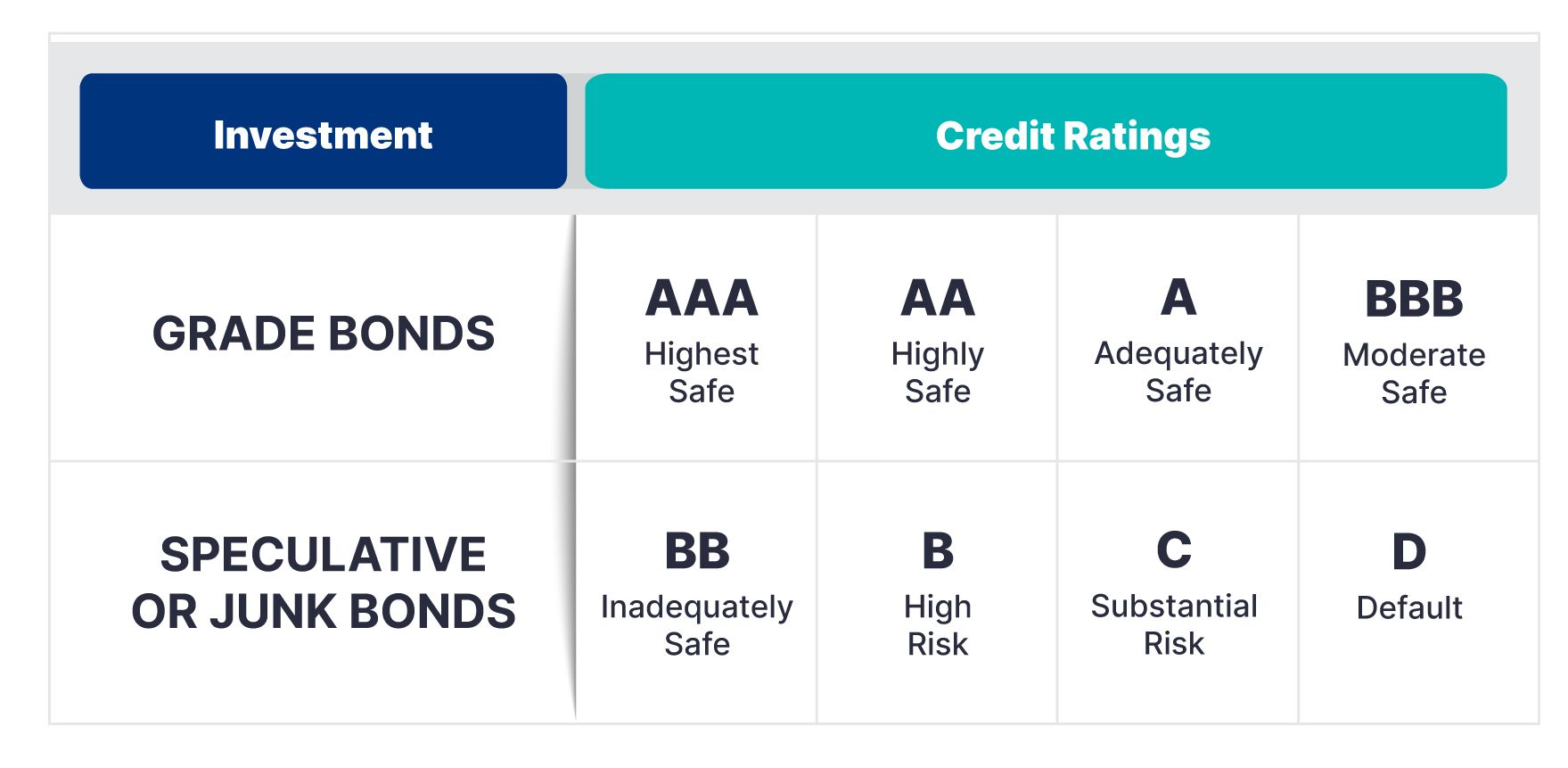An investment grade rating indicates that a municipal or corporate bond has a comparatively low risk of default. Bond rating companies such as Standard & Poor's (S&P), Moody's, and Fitch employ distinct designations, consisting of the upper- and lower-case letters "A" and "B," to indicate a bond's credit quality rating.
"AAA" and "AA" (high credit quality), as well as "A" and "BBB" (medium credit quality), are considered investment grade. Bonds with credit ratings lower than these designations ("BB," "B," "CCC," etc.) are deemed poor credit quality and are popularly known as trash bonds.
How Investment Grade Works
Credit ratings are based on an individual or business's credit history. Lenders use these ratings to determine if they will do business with and give credit to prospective borrowers. Similarly, assets are assigned credit ratings, which lenders and investors may use to decide whether to invest in them.
Grades serve as credit ratings for both people and businesses. An investment grade credit rating suggests a minimal risk of credit default, making it a desirable investment option, particularly for conservative investors. A speculative grade is the reverse of an investment grade. This grade implies that the investment has a higher level of risk.
Investments are rated by many organizations, including S&P, Moody's, and Fitch. The way they are graded differs depending on the agency. For example:
S&P assigns letter grades using plus (+) and negative (-) suffixes. Triple-letter ratings are higher, followed by double-letter ratings, and finally single-letter ratings.
Moody's assigns the highest rating to assets with triple-letter ratings, followed by those with letters and digits.
The Fitch rating scale is identical to the S&P's.
We go into further depth about these ratings and their scales below.
Special Considerations
U.S. government bonds, or Treasuries, typically have the highest credit quality rating. Municipal and corporate bond funds often reflect "average credit quality" for their portfolios, as reported in their prospectus and independent investment research studies.
In August 2023, Fitch reduced the United States' credit rating from AAA to AA+. The organization identified probable problems with the country's budgetary situation over the next three years due to the political atmosphere. According to Fitch,"...repeated debt-limit political standoffs and last-minute resolutions have eroded confidence in fiscal management."
Fitch warns that tax cuts and government expenditures are increasing the national debt, potentially affecting the country's capacity to pay payments.2
Many institutional investors have a strict policy of restricting their bond investments to investment-grade securities.3
Investment Grade Credit Rating Details
Investment grade issuer credit ratings are those rated above BBB- or Baa. The exact ratings depend on the credit rating agency.
Standard & Poor's (S&P)
Investment grade credit ratings include:
- AAA
- AA+
- AA
- AA-
Companies with any credit rating in this category boast a high capacity to repay their loans; however, those awarded a AAA rating stand at the top of the heap and are deemed to have the highest capacity of all to repay loans.
Companies with these ratings are considered to be stable entities with robust capacities for repaying their financial commitments. However, such companies may encounter challenges during deteriorating economic conditions.
The bottom tier of investment grade credit ratings delivered by Standard and Poor's include:
- BBB+
- BBB
- BBB-
Companies with these ratings are widely considered to be speculative grade and are even more vulnerable to changing economic conditions than the prior group. Nevertheless, these companies largely demonstrate the ability to meet their debt payment obligations.4
Moody's
According to Moody's, investment-grade bonds comprise the following credit ratings:
- Aaa
- Aa1
- Aa2
- Aa3
- A1
- A2
The highest-rated Aaa bonds possess the least credit risk of a company's potential failure to repay loans. By contrast, the mid-tier Baa-rated companies may still have speculative elements, presenting high credit risk—especially those companies that paid debt with expected future cash flows that failed to materialize as projected.5
Downgrading from Investment Grade
When a company's bonds are downgraded from 'BBB' to 'BB' by an agency, the debt is reclassified from investment grade to junk status. Although this is just a one-step decline in credit rating, the consequences may be serious.
The decline to junk rating indicates that a corporation may struggle to pay its obligations. The degraded status may make it much more difficult for enterprises to get funding, resulting in a negative loop as capital expenses rise.7
What Is Investment Grade vs. High Yield?
High yield bonds are generally considered higher risk than investment grade bonds. High yield bonds, however, tend to offer a higher return—to compensate for the higher risk of default of the issuer.7
What Is Considered Investment Grade?
According to Fitch and S&P Global, an investment grade of BBB- or above is regarded to be an investment grade. For Moody's, an investment grade of Baa3 or above is deemed to be acceptable.
